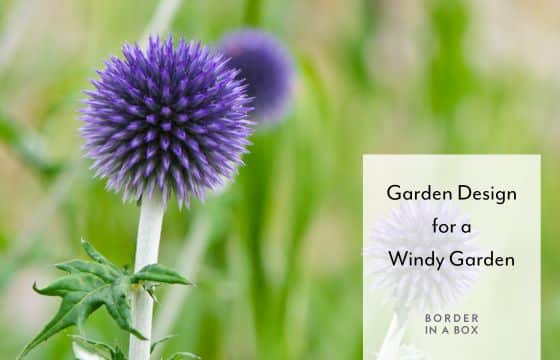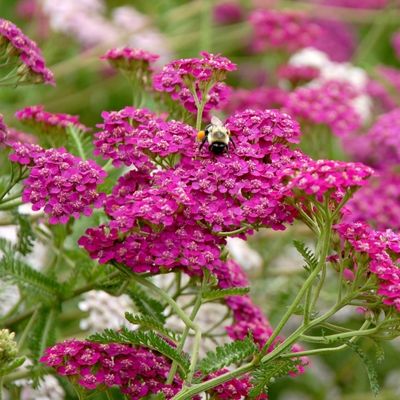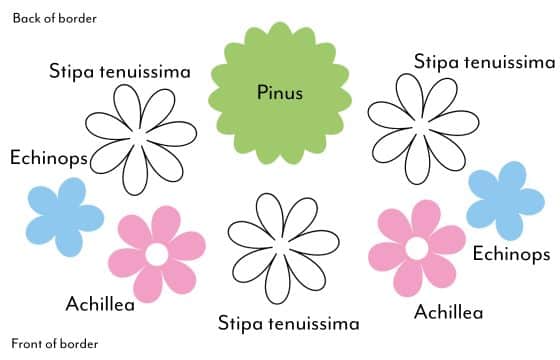Garden design for a windy garden

Garden Design For A Windy Garden in the UK
Creating a garden in a windy area can be challenging, but not impossible. With some planning, protection, and the right plant selection, you can create a garden that is beautiful, productive, and resilient. Here’s my top tips to help you choose the right plants for your windy garden.
Why windy gardens can be challenging.
Wind can cause a lot of problems for plants such as:
- Damaging or breaking plant stems, leaves, and flowers, especially if they are thin, delicate, or tall.
- It can dry out the soil and the plants, causing them to wilt or die from dehydration.
- Wind can blow away seeds, pollen, and beneficial insects, reducing the chances of pollination and reproduction.
- Wind can increase the risk of fungal diseases, as it spreads spores.
How to Protect Your Garden from Wind
The best way to deal with wind is to reduce its impact on your garden. This can be done in several ways:
- Create a living windbreak on the windward side of your garden. This can be a hedge or a row of trees or shrubs that can filter and slow down the wind. Make sure that the windbreak is not too solid or high, as this can create turbulence and increase wind speed on the other side. A good windbreak should have gaps or openings that allow some air to pass through.
- Mulch your soil with organic matter, such as compost, bark, straw, or grass clippings. This can help retain moisture, prevent erosion, and add nutrients to your soil.
- Stake, tie, or support your plants with bamboo canes, trellises, or wires. This can help them withstand wind and prevent damage or breakage.
- Water your plants regularly and deeply, especially during dry and windy periods. This can help them stay hydrated and healthy.
- Prune your plants regularly to remove dead, damaged, or diseased parts. This can help them maintain a compact and sturdy shape and reduce wind resistance.
Choose Plants Suitable for a Windy Garden:
The most important factor to consider when choosing plants for a windy garden is their tolerance to wind exposure. Some plants are more adapted to windy conditions than others, and they have certain characteristics that make them resilient. Some of these characteristics are:
- Thick, leathery, waxy, hairy, or needle-like leaves that reduce water loss and prevent tearing.
- Small, inconspicuous, or tubular flowers that are less likely to be damaged by wind.
- Strong, flexible, or woody stems that can bend without breaking.
- Low-growing or spreading habits that hug the ground and avoid wind exposure.
- Deep or extensive root systems that anchor the plants firmly in the soil.
Here are some examples of plants that are suitable for windy gardens in the UK:
Trees
Trees can provide shade, structure, and shelter for your garden. They are also needed for birds and wildlife:
Alder: A fast-growing tree with catkins and cones that tolerates wet and windy conditions.
Hawthorn: A thorny tree with fragrant white flowers in May followed by red berries in autumn that are loved by bees, birds, and butterflies. Great for hedges too.
Pine: the thin needle-like leaves and cones can withstand drought and salt spray. Pinus mugo is a small variety that is ideal for smaller gardens as it grows to around 1.5m tall and is slow growing.
Shrubs
Shrubs can add colour, texture, and interest to your garden. They can also act as windbreaks or hedges for smaller areas. Some of the best shrubs for windy gardens are:
Brachyglottis: An evergreen shrub with grey-green leaves and yellow daisy-like flowers that tolerates dry and salty conditions.
Heather: A low-growing shrub with needle-like leaves and pink, purple, or white flowers that thrives in acidic and well-drained soils.
Berberis thunbergii ‘Tiny Gold’ – this is a small shrub that grows to around 50cm tall with lime green foliage which contrasts beautifully with purple leaves or flowers.
Grasses and Perennials
Grasses and perennials can create movement and contrast in your garden. They can also soften the edges of your borders and fill the gaps between other plants.
Stipa gigantea: One of my favourite grasses to use in any garden. It grows to around 2.5m tall with arching stems of oat-like seed heads. It rustles when the breeze blows through it, so its ideal for a sensory garden too.
Stipa tenuissima: is a smaller grass that grows to around 60cm tall when fully mature. It has lovely wispy golden leaves too.
Eryngium: A spiny shrub with blue or silver flowers and foliage that is commonly known as sea holly.
Erysimum: A perennial wallflower with fragrant purple, pink, or yellow flowers that blooms from spring to autumn.
Echinops: Commonly known as a globe thistle with beautiful blue pom pom style seed head flowers on silvery stems.
Yarrow (Achillea): A drought-tolerant plant with fern-like leaves and flat flower clusters of yellow, pink, or white flowers that can be used as a cut or dried flowers.

Achillea

Stipa tenuissima (surrounding a pittosporum)

Echinops
Simple planting plan:

Once the garden has been planted, place a layer of mulch around the plants such as gravel which will add additional texture to the border.
Any questions, just ask!
 Free Delivery
Free Delivery Upgrade to 24 Hour Tracked Delivery
Upgrade to 24 Hour Tracked Delivery

